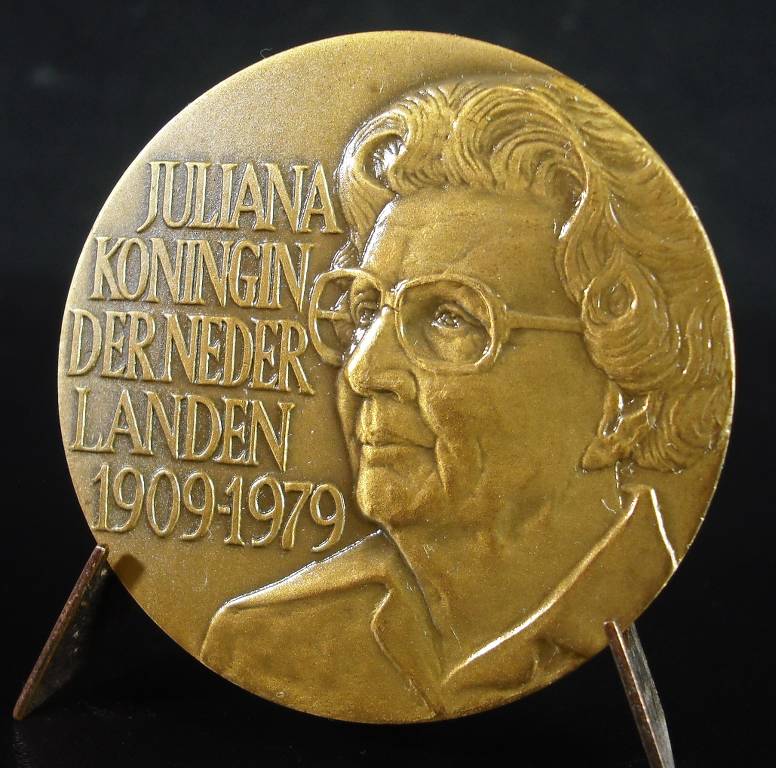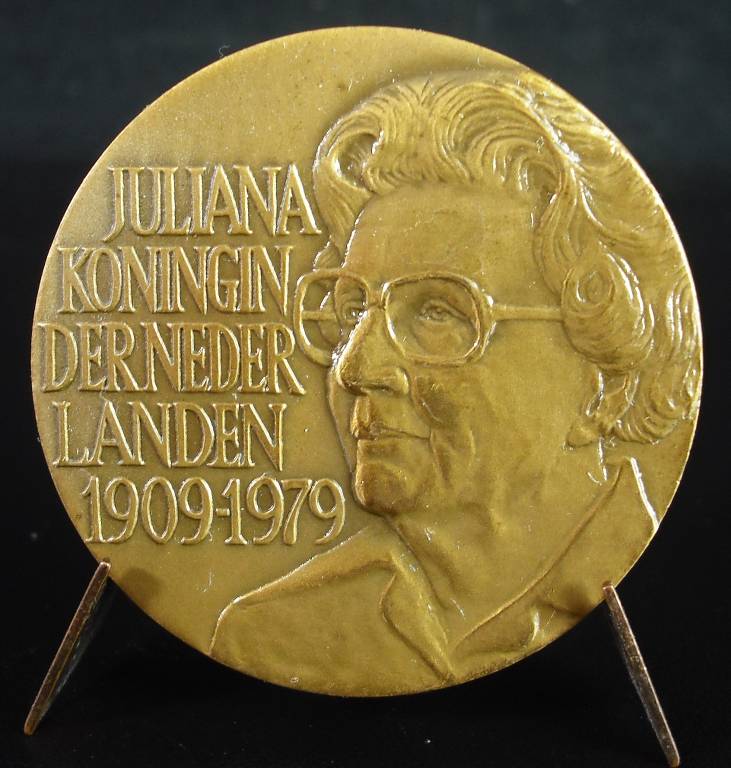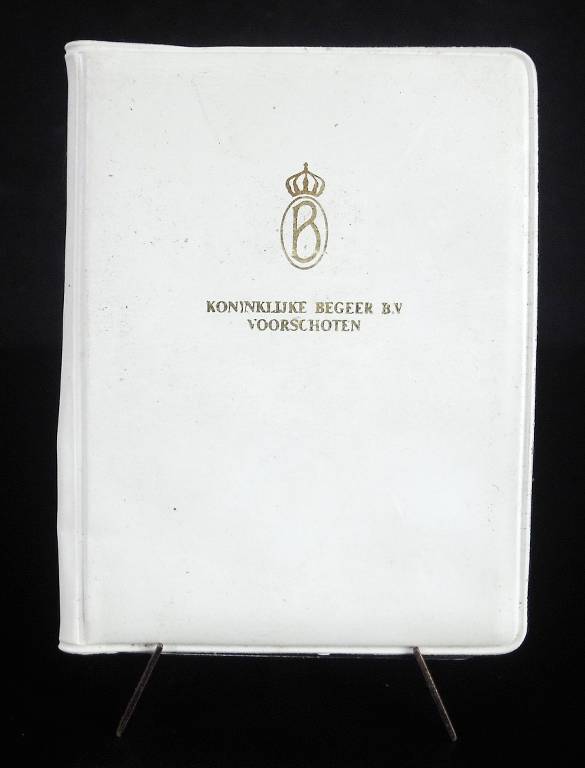Bronze medal, Holland.
Minted around 1979.
Some minor defects.
Copy in its pouch.
Artist, engraver, sculptor: to be determined.
Dimensions : 50mm.
Weight : 46 g.
Metal : bronze .
Hallmark on the edge (mark on the edge) : none .
Quick and neat delivery.
The stand is not for sale.
The support is not for sale.
Weight : 46 g.
Metal : bronze .
Hallmark on the edge (mark on the edge) : none .
Quick and neat delivery.
The stand is not for sale.
The support is not for sale.
Juliana of the Netherlands, born April 30, 1909 in The Hague and died Mars 20, 2004 at Soestdijk Palace (Baarn), was Queen of the Netherlands from September 6, 1948 to April 30, 1980. Princess of Orange-Nassau and Duchess of Mecklenburg-Schwerin, she is also Princess of Lippe-Biesterfeld by marriage.
Biography
Birth and family
Queen Juliana is the only daughter of Queen Wilhelmina of Orange-Nassau of the Netherlands and Duke Henry of Mecklenburg-Schwerin. The latter was born Heinrich, herzog von Mecklenburg-Schwerin. On his wedding day, he received the title of Prince of the Netherlands with the predicate of royal highness but not the title of Prince of Orange. His first name officially became Hendrik also on his wedding day.
Queen Wilhelmina established by decree that her descendants would bear the title of prince(s) of Orange-Nassau before that of duke(s) of Mecklenburg-Schwerin.
Queen Juliana of the Netherlands belongs to the House of Orange-Nassau. It comes from the sixth branch (Nassau-Dietz), a branch of the second branch (Nassau-Dillenbourg) of the house of Nassau.
Marriage and descendants
On January 7, 1937, she married Prince Bernhard of Lippe-Biesterfeld, also created royal highness. They have four daughters:
Princess Beatrix (born 1938), Queen of the Netherlands (1980-2013);
Princess Irene (born 1939);
Princess Margriet (born in 1943);
Princess Christina (1947-2019).
Regent of his mother
She held the position of princess-regent twice, before being enthroned queen of the Netherlands, on September 6, 1948, in the new church in Amsterdam, two days after the abdication of Queen Wilhelmina, her mother.
The following year, she signed the transfer of sovereignty of the Dutch East Indies (today's Indonesia) to the republican government in Batavia (today's Jakarta).
Queen of the Netherlands
Advent and public image
Parade in New York in honor of Queen Juliana, April 1952.
His accession to the throne changed the image of the monarchy in the Netherlands: there was talk of a “bicycle monarchy”, an attitude which appealed to the Dutch people. Juliana said she was disgusted with protocol and a very simple woman, but could sometimes be very princely when the occasion demanded it. She was very popular, particularly for her presence alongside residents affected by the severe floods of 1953. She would later denounce the Cold War before the United States Congress in Washington.
Successive crises
In 1956, Greet Hofmans, a healer who exerted a strong influence on the queen, caused tension within the royal couple. This crisis, which degenerated into conflict between the queen and the government, almost cost her her throne1.
Before her marriage to Charles-Hugues de Bourbon-Parma, pretender to the Spanish throne, her daughter Irene converted to Catholicism in 1964. In love with the controversial prince, Irene marries him against the advice of Parliament.
In the Lockheed affair, in 1975, Prince Bernhard was accused of passive corruption, the government of Prime Minister Joop den Uyl was shaken and the monarchy could only be maintained by abandoning the office of inspector general of the armies. occupied by the prince. In a posthumous interview, Prince Bernhard confirmed his involvement in the Lockheed affair and also revealed the existence of two illegitimate daughters.
Abdication of Juliana
This affair may have precipitated Juliana's abdication, on April 30, 1980, her 71st birthday, in favor of her eldest daughter Béatrix. The former queen then takes back the title of HRH Princess Juliana of the Netherlands, and retires with Prince Bernhard to Soestdijk Palace.
After the reign
Withdrawal from public life
After the year 2000, Princess Juliana reduced her public appearances, while Prince Bernhard continued to participate occasionally, alongside his daughter Queen Beatrix, in various events.
Death of the Queen
Juliana died in her sleep, on Mars 20, 2004, the day of the 70th anniversary of the death of her grandmother Emma de Waldeck-Pyrmont, at Soestdijk Palace, in the presence of her family, from pneumonia combined with a condition of great general weakness. His funeral took place in Delft, the Orange burial site, in the presence of all the “Gotha”.
Death of her husband
Her husband, Prince Bernhard, died less than a year later, on December 1, 2004, at the University Hospital of Utrecht, at the age of 93, from cancer.
Title
Born princess of the Netherlands, she took up this title after her abdication in 1980. Juliana successively bears the titles of:
Her Royal Highness Princess Juliana of the Netherlands, Princess of Orange-Nassau, Duchess of Mecklenburg (1909-1937);
Her Royal Highness Princess Juliana of the Netherlands, Princess of Orange-Nassau, Duchess of Mecklenburg, Princess of Lippe-Biesterfeld (1937-1948);
Her Majesty the Queen of the Netherlands (1948-1980);
Her Royal Highness Princess Juliana of
Biography
Birth and family
Queen Juliana is the only daughter of Queen Wilhelmina of Orange-Nassau of the Netherlands and Duke Henry of Mecklenburg-Schwerin. The latter was born Heinrich, herzog von Mecklenburg-Schwerin. On his wedding day, he received the title of Prince of the Netherlands with the predicate of royal highness but not the title of Prince of Orange. His first name officially became Hendrik also on his wedding day.
Queen Wilhelmina established by decree that her descendants would bear the title of prince(s) of Orange-Nassau before that of duke(s) of Mecklenburg-Schwerin.
Queen Juliana of the Netherlands belongs to the House of Orange-Nassau. It comes from the sixth branch (Nassau-Dietz), a branch of the second branch (Nassau-Dillenbourg) of the house of Nassau.
Marriage and descendants
On January 7, 1937, she married Prince Bernhard of Lippe-Biesterfeld, also created royal highness. They have four daughters:
Princess Beatrix (born 1938), Queen of the Netherlands (1980-2013);
Princess Irene (born 1939);
Princess Margriet (born in 1943);
Princess Christina (1947-2019).
Regent of his mother
She held the position of princess-regent twice, before being enthroned queen of the Netherlands, on September 6, 1948, in the new church in Amsterdam, two days after the abdication of Queen Wilhelmina, her mother.
The following year, she signed the transfer of sovereignty of the Dutch East Indies (today's Indonesia) to the republican government in Batavia (today's Jakarta).
Queen of the Netherlands
Advent and public image
Parade in New York in honor of Queen Juliana, April 1952.
His accession to the throne changed the image of the monarchy in the Netherlands: there was talk of a “bicycle monarchy”, an attitude which appealed to the Dutch people. Juliana said she was disgusted with protocol and a very simple woman, but could sometimes be very princely when the occasion demanded it. She was very popular, particularly for her presence alongside residents affected by the severe floods of 1953. She would later denounce the Cold War before the United States Congress in Washington.
Successive crises
In 1956, Greet Hofmans, a healer who exerted a strong influence on the queen, caused tension within the royal couple. This crisis, which degenerated into conflict between the queen and the government, almost cost her her throne1.
Before her marriage to Charles-Hugues de Bourbon-Parma, pretender to the Spanish throne, her daughter Irene converted to Catholicism in 1964. In love with the controversial prince, Irene marries him against the advice of Parliament.
In the Lockheed affair, in 1975, Prince Bernhard was accused of passive corruption, the government of Prime Minister Joop den Uyl was shaken and the monarchy could only be maintained by abandoning the office of inspector general of the armies. occupied by the prince. In a posthumous interview, Prince Bernhard confirmed his involvement in the Lockheed affair and also revealed the existence of two illegitimate daughters.
Abdication of Juliana
This affair may have precipitated Juliana's abdication, on April 30, 1980, her 71st birthday, in favor of her eldest daughter Béatrix. The former queen then takes back the title of HRH Princess Juliana of the Netherlands, and retires with Prince Bernhard to Soestdijk Palace.
After the reign
Withdrawal from public life
After the year 2000, Princess Juliana reduced her public appearances, while Prince Bernhard continued to participate occasionally, alongside his daughter Queen Beatrix, in various events.
Death of the Queen
Juliana died in her sleep, on Mars 20, 2004, the day of the 70th anniversary of the death of her grandmother Emma de Waldeck-Pyrmont, at Soestdijk Palace, in the presence of her family, from pneumonia combined with a condition of great general weakness. His funeral took place in Delft, the Orange burial site, in the presence of all the “Gotha”.
Death of her husband
Her husband, Prince Bernhard, died less than a year later, on December 1, 2004, at the University Hospital of Utrecht, at the age of 93, from cancer.
Title
Born princess of the Netherlands, she took up this title after her abdication in 1980. Juliana successively bears the titles of:
Her Royal Highness Princess Juliana of the Netherlands, Princess of Orange-Nassau, Duchess of Mecklenburg (1909-1937);
Her Royal Highness Princess Juliana of the Netherlands, Princess of Orange-Nassau, Duchess of Mecklenburg, Princess of Lippe-Biesterfeld (1937-1948);
Her Majesty the Queen of the Netherlands (1948-1980);
Her Royal Highness Princess Juliana of
Honors
Foreign decorations
ARG Order of the Liberator San Martin - Grand Cross BAR Grand cross with collar of the order of the Liberator General San Martín (Argentina)
AUT Honor for Services to the Republic of Austria - 2nd Class BAR Grand Star of the Decoration of Honor for Services to the Republic (Austria)
Grand Crest Order of Leopold Knight Grand Cross of the Order of Leopold I (Belgium)
BEL Kroonorde Grootkruis BAR Knight Grand Cross of the Order of the Crown (Belgium) (Belgium)
BRA Order of the Southern Cross - Grand Cross BAR Grand cross with collar of the Order of the Southern Cross (Brazil)
Order of Valor (Cameroon) GC 2nd type ribbon Grand Cross of the Order of Valor (Cameroon)
Order of Boyacá - Extraordinary Grand Cross (Colombia) - ribbon bar Grand cross with collar of the order of Boyacá (Colombia)
Order of San Carlos - Grand Cross (Colombia) - ribbon bar Grand cross of the order of San Carlos (Colombia)
ROK Order of Merit for National Foundation - Order of the Republic of Korea Member of the Order of Merit for the National Foundation, “Order of the Republic of Korea”, 1st class (South Korea)
CHL Order of Merit of Chile - Grand Cross BAR Grand cross with collar of the Order of Merit (Chile)
TWN Order of Propitious Clouds 1Class BAR Grand Cross of the Order of Propitious Clouds (Republic of China)
CZE Rad Bileho Lva 3 tridy BAR Grand Cross with Collar of the Order of the White Lion (Czechoslovakia)
Order of the Elephant Ribbon bar Knight of the Order of the Elephant (Denmark)
DOM Order of Merit of Duarte, Sanchez and Mella ribbon Grand Cross of the Order of Merit of Duarte, Sánchez and Mella (Dominican Republic)
Ribbon bar of Orden Nacional de San Lorenzo Grand Cross with Collar of the National Order of San Lorenzo (Ecuador)
ETH Order of Solomon BAR Knight of the Order of Solomon (Ethiopia)
ETH Order of Solomon BAR Knight Grand Cordon of the Order of the Seal of Solomon (Ethiopia)
FIN Order of the White Rose Grand Cross BAR Grand cross with necklace of the Order of the White Rose (Finland)
Legion Honor GC ribbon Grand Cross of the Order of the Legion of Honor (France)
D-PRU Hohenzollern Order BAR Lady of the
Foreign decorations
ARG Order of the Liberator San Martin - Grand Cross BAR Grand cross with collar of the order of the Liberator General San Martín (Argentina)
AUT Honor for Services to the Republic of Austria - 2nd Class BAR Grand Star of the Decoration of Honor for Services to the Republic (Austria)
Grand Crest Order of Leopold Knight Grand Cross of the Order of Leopold I (Belgium)
BEL Kroonorde Grootkruis BAR Knight Grand Cross of the Order of the Crown (Belgium) (Belgium)
BRA Order of the Southern Cross - Grand Cross BAR Grand cross with collar of the Order of the Southern Cross (Brazil)
Order of Valor (Cameroon) GC 2nd type ribbon Grand Cross of the Order of Valor (Cameroon)
Order of Boyacá - Extraordinary Grand Cross (Colombia) - ribbon bar Grand cross with collar of the order of Boyacá (Colombia)
Order of San Carlos - Grand Cross (Colombia) - ribbon bar Grand cross of the order of San Carlos (Colombia)
ROK Order of Merit for National Foundation - Order of the Republic of Korea Member of the Order of Merit for the National Foundation, “Order of the Republic of Korea”, 1st class (South Korea)
CHL Order of Merit of Chile - Grand Cross BAR Grand cross with collar of the Order of Merit (Chile)
TWN Order of Propitious Clouds 1Class BAR Grand Cross of the Order of Propitious Clouds (Republic of China)
CZE Rad Bileho Lva 3 tridy BAR Grand Cross with Collar of the Order of the White Lion (Czechoslovakia)
Order of the Elephant Ribbon bar Knight of the Order of the Elephant (Denmark)
DOM Order of Merit of Duarte, Sanchez and Mella ribbon Grand Cross of the Order of Merit of Duarte, Sánchez and Mella (Dominican Republic)
Ribbon bar of Orden Nacional de San Lorenzo Grand Cross with Collar of the National Order of San Lorenzo (Ecuador)
ETH Order of Solomon BAR Knight of the Order of Solomon (Ethiopia)
ETH Order of Solomon BAR Knight Grand Cordon of the Order of the Seal of Solomon (Ethiopia)
FIN Order of the White Rose Grand Cross BAR Grand cross with necklace of the Order of the White Rose (Finland)
Legion Honor GC ribbon Grand Cross of the Order of the Legion of Honor (France)
D-PRU Hohenzollern Order BAR Lady of the






